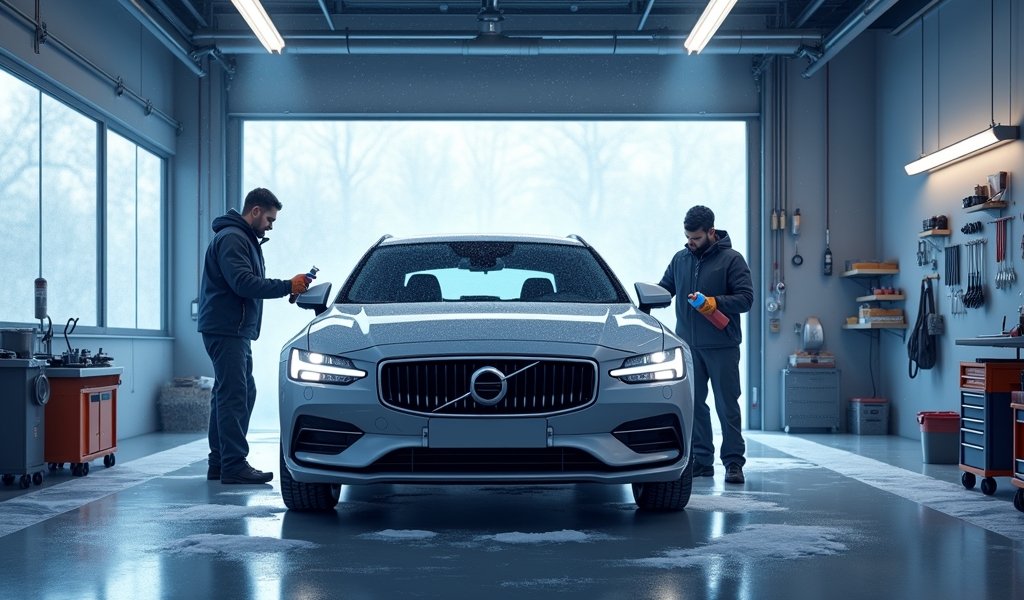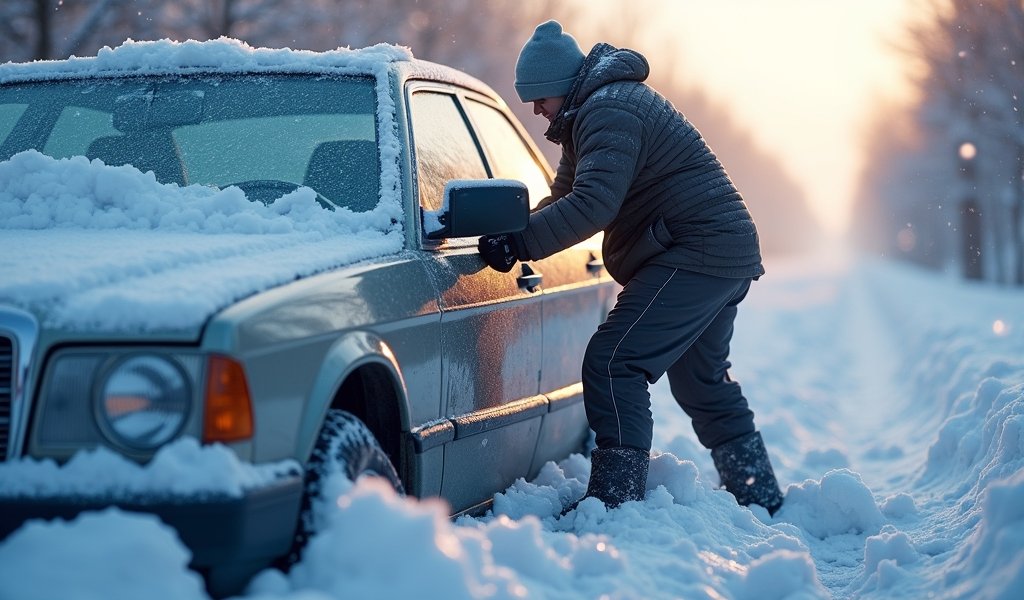Overview
This winter vehicle protection guide covers comprehensive strategies from pre-season preparation (including fluid checks, battery care, and winter tires) to ongoing protection methods (proper snow removal, regular washing, and undercarriage maintenance). The article emphasizes that consistent preventative care is more cost-effective than repairs, while providing practical advice for exterior protection, interior moisture control, windshield care, and emergency preparedness.
Table of Contents
- Understanding Winter Threats to Your Vehicle
- Pre-Winter Preparation: Your First Line of Defense
- Exterior Protection Strategies
- Daily Protection During Winter Months
- Windshield and Glass Protection
- Interior Protection Tips
- Post-Storm Car Care
- Winter Emergency Kit Essentials
- Conclusion
- Frequently Asked Questions
Understanding Winter Threats to Your Vehicle
Winter isn’t just rough on us humans – it’s particularly harsh on our vehicles. As someone who’s spent decades under the hood, I’ve seen firsthand how snow and ice can transform a pristine vehicle into a corroded mess in just one season. The key to protecting your car from snow and ice starts with understanding exactly what you’re up against.
Think of winter as waging a multi-front attack on your vehicle. On one front, there’s the direct assault: snow piling up, adding weight to your car and potentially damaging wipers and antennas. On another front, there’s ice formation, which can crack windshields, freeze moving parts, and make driving treacherous. But perhaps the most insidious attack comes from road salt and de-icing chemicals – silent corrosion agents that eat away at your undercarriage like acid through paper.
Road salt is particularly nasty business. It lowers the freezing point of water, which helps keep roads safer, but this same chemical property accelerates the rusting process on your vehicle’s metal components. Have you ever noticed those rusty holes in older cars? Chances are they started as tiny salt-induced corrosion spots that grew season after season.
Temperature fluctuations create another problem. As temperatures rise and fall, snow melts and refreezes, working its way into cracks and crevices. When water freezes, it expands by about 9% – enough to worsen existing damage in your car’s finish or components. I’ve seen this freeze-thaw cycle transform a tiny paint chip into a quarter-sized rust spot in just one winter.

Pre-Winter Preparation: Your First Line of Defense
Preparing your car before winter hits is like putting on armor before battle. Trust me, the hour or two you spend getting ready will save you headaches (and potentially hundreds in repairs) down the road.
Essential Maintenance Checklist
Start with a thorough inspection of your vehicle’s critical systems. Your visibility and control are paramount in winter conditions, so check all lights, replace worn wiper blades with winter-specific ones, and ensure your heating and defrosting systems work perfectly. When visibility drops during a snowstorm, you’ll be grateful for that new set of wiper blades.
Next, check all rubber components – cold temperatures make rubber brittle. Inspect belts, hoses, and weatherstripping around doors and windows for cracks or wear. A failed hose in summer is inconvenient, but in winter, it could leave you stranded in dangerous conditions.
Fluid Checks and Replacements
- Antifreeze/Coolant: Ensure it’s at the proper concentration to prevent freezing. Consider a complete flush if it’s been more than two years.
- Oil: Consider switching to a winter-grade oil that flows better in cold temperatures.
- Windshield Washer Fluid: Replace with a winter formula with a lower freezing point.
- Brake Fluid: Check levels and condition, as brake performance is especially crucial on slippery roads.
Battery Preparation
Your battery works harder in cold weather while delivering less power – a nasty combination. A battery that seems fine in fall might leave you stranded on the first cold morning. Proper battery care in cold weather can mean the difference between a reliable start and a frustrating call for help.
Have your battery professionally tested, especially if it’s more than three years old. Clean the terminals and connections to ensure good contact – corrosion creates resistance that makes starting harder. In extremely cold regions, consider a battery insulator or engine block heater. According to a National Renewable Energy Laboratory study, battery capacity can drop by up to 50% at 0°F (-18°C).
Winter Tire Considerations
All-season tires become increasingly ineffective below 45°F (7°C). Winter tires use special rubber compounds that stay flexible in cold temperatures and feature tread patterns designed specifically for snow and ice traction. Think of them as specialized footwear for your car – you wouldn’t wear dress shoes to hike a snowy mountain, would you?
Install winter tires on all four wheels – mixing tire types creates dangerous handling imbalances. Check tire pressure weekly, as it can drop in cold weather. For extreme conditions, consider studdable tires or tire chains where permitted by local regulations.
Exterior Protection Strategies
With mechanical preparation complete, it’s time to shield your car’s body from winter’s assault. I’ve seen countless vehicles where owners maintained the mechanical components perfectly but neglected the body, resulting in premature aging and reduced value.
Waxing and Sealants: Your Paint’s Shield
Think of wax as your paint’s winter coat. Apply a quality carnauba wax or synthetic sealant before the first snowfall – this creates a sacrificial barrier between your paint and winter contaminants. The smooth surface also makes it harder for ice and snow to adhere to your car, making cleanup easier.
For superior protection, consider a ceramic coating applied by professionals. These create a semi-permanent bond with your paint that can last several years and provide excellent protection against salt, ice, and other winter contaminants. Yes, they’re pricier than traditional wax, but the protection they offer is unmatched.
Undercarriage Protection
Your car’s underbody takes the brunt of winter’s assault yet receives the least attention. Preparing your car for road salt should include undercarriage protection strategies.
Consider a professional undercarriage treatment that applies a protective coating to shield against salt and moisture. Many car washes offer undercarriage spray options – use them regularly. For DIY enthusiasts, spray-on protective coatings are available, though they require careful application in a well-ventilated area.
Protecting Chrome and Exposed Metal
Chrome trim and exposed metal accents quickly show winter’s effects. Apply a specific chrome protectant or paste wax to create a barrier against salt. For aluminum or other metals, use appropriate metal sealants. Remember that these areas may need more frequent reapplication throughout winter.
Daily Protection During Winter Months
Once winter arrives in full force, your daily habits become your most important protection strategy. Small actions, consistently applied, make an enormous difference in how your vehicle weathers the season.
Proper Snow Removal Techniques
The way you remove snow can either protect or damage your vehicle. Use a foam brush or soft snow broom – never a shovel or hard-edged tool that can scratch paint or damage trim. Start from the top (your roof) and work downward, clearing the roof first to prevent snow from sliding onto already-cleared areas.
Always remove all snow from your vehicle before driving – not just from windows. Snow left on your roof can slide forward under braking, blocking your view, or backward onto following vehicles. In many states, driving with snow on your vehicle is illegal for these safety reasons.
Safe Ice Removal Methods
Ice removal requires even more care than snow removal. Never use hot water on a frozen windshield – the thermal shock can crack glass. Start your car and use the defroster to help loosen ice before removal. Use plastic scrapers designed for automotive use, and work from edges toward the center for more efficient clearing.
Commercial de-icer sprays can speed up the process, but choose ones formulated for automotive use that won’t damage paint or rubber seals. In a pinch, a solution of two parts rubbing alcohol to one part water in a spray bottle works for light ice.
Dealing with Road Salt
Wash your car frequently during winter, especially after major road salt applications. Pay special attention to wheel wells, undercarriage, and lower body panels. If temperatures permit (above freezing), try to wash your car at least every two weeks. Choose car washes with undercarriage spray options for more thorough salt removal.
Parking Strategies
Where you park makes a significant difference in winter protection. A heated garage is ideal, allowing snow and ice to melt naturally and completely. An unheated garage still provides substantial protection from direct snow and ice. If garage parking isn’t available, waterproof car covers for winter can help, but ensure they’re designed for winter use to prevent moisture trapping.

Windshield and Glass Protection
Your ability to see clearly is paramount for winter safety. I’ve responded to too many winter accidents where poor visibility was a factor – don’t let your vehicle become one of those statistics.
Preventing and Removing Ice Buildup
Apply a silicone-based water repellent to your windshield before winter to make ice removal easier. These products create a hydrophobic surface that prevents water from bonding strongly with the glass, making ice removal significantly easier. Consumer Reports tests show that proper glass treatment can reduce ice adhesion by up to 70%.
When removing ice, use a plastic ice scraper with a smooth edge. Work from the edges toward the center when removing ice for more efficient clearing. Never use metal scrapers or improvised tools like credit cards that can scratch glass or damage heating elements in rear windows.
Protecting Wiper Blades
Wiper blades take a beating in winter. Pull wipers away from the windshield when parked during snowfall to prevent freezing to the glass. Never use wipers to clear ice – this damages the rubber edges and can burn out the wiper motor.
Consider winter-specific wiper blades with protected rubber elements that resist ice buildup. Keep washer fluid full with a winter-specific formula rated for your local temperature extremes. Nothing is more frustrating than spraying your windshield only to have the fluid freeze on contact.
Preventing Door Lock Freezing
Few things are more frustrating than being unable to enter your car because the locks are frozen. Commercial lock de-icers work well, but prevention is better. Apply a thin layer of WD-40 or specialized lock lubricant to key holes before winter sets in. Keep a small bottle of glycerin-based lubricant to apply to frozen keyholes in emergencies.
For cars with remote keyless entry, keep the battery in your key fob fresh during winter. Cold temperatures reduce battery performance, and a weak fob battery might fail just when you need it most.
Interior Protection Tips
Your car’s interior faces unique challenges during winter. Moisture from boots and clothing, salt residue, and temperature fluctuations can all cause damage if not properly managed.
Dealing with Tracked-in Snow and Salt
Snow melts quickly once inside your warm car, creating a perfect environment for moisture damage and salt corrosion. Shake off boots and clothing before entering your vehicle. If possible, remove slush from wheel wells and undercarriage before garage parking to prevent melting slush from creating a high-humidity environment.
Keep a small towel in the car to wipe up immediate spills and moisture. This simple habit can prevent water stains on upholstery and corrosion of floor pan metal over time.
Protecting Floor Mats and Carpeting
Invest in high-quality, winter-specific floor liners with raised edges to contain melting snow and salt. These are more expensive than basic mats but offer superior protection for your carpeting. For vehicles with valuable interiors, consider temporary carpet protectors for areas not covered by mats.
Remove and empty floor mats regularly to prevent salt and moisture buildup. Allow them to dry completely before reinstalling – trapped moisture under mats accelerates corrosion of the floor pan.
Moisture Control Inside the Vehicle
Excess moisture inside your car can lead to foggy windows, musty odors, and even mold growth. Use absorbent products like silica gel packets or commercial moisture absorbers designed for vehicles. Ensure your cabin air filter is clean for proper ventilation – a clogged filter reduces air circulation and can increase interior humidity.
On warmer winter days, air out your vehicle briefly to release accumulated moisture. Running your air conditioning occasionally (yes, even in winter) helps dry the air inside your vehicle and prevents mold growth in the system.
Post-Storm Car Care
After the storm passes, prompt attention can prevent long-term damage. Think of post-storm care as damage control – addressing the effects of exposure before they can cause lasting harm.
Proper Washing Techniques
Winter car washing requires special considerations. Wait until temperatures are above freezing if possible to prevent doors and locks from freezing shut after washing. Choose car washes with undercarriage spray options to remove salt from hard-to-reach areas. Hand-dry your car after washing when possible to prevent water from freezing in seams and crevices.
Pay special attention to wheel wells, rocker panels, and behind trim pieces where salt and slush accumulate. A pressure washer set to moderate pressure can help remove packed snow and salt from these areas if used carefully.
Checking for Damage After Storms
Regular inspection can catch small issues before they become big problems. Look for paint chips that might have occurred during ice removal – these are entry points for corrosion. Check door jambs and seals for ice buildup that could damage weatherstripping. Inspect wiper blades for damage from ice scraping and examine trim pieces for signs of salt damage or loosening.
Address small problems immediately. Touch up paint chips with manufacturer-matched paint pens. Apply protective wax to affected areas after repair. Replace damaged wiper blades instead of continuing to use deteriorated ones that could scratch your windshield.
Winter Emergency Kit Essentials
Being prepared for winter emergencies is part of comprehensive car care. Winter weather can strand even the best-maintained vehicles, so preparation is crucial.
Must-have Items for Winter Driving
- Blanket or emergency thermal blanket
- Extra gloves, hat, and warm clothing
- Flashlight with fresh batteries
- First aid kit
- Portable phone charger
- Small shovel
- Bag of sand or cat litter for traction
- Energy bars or non-perishable snacks
- Water in containers that won’t burst if frozen
- Basic tool kit
De-icing Tools and Supplies
Your winter emergency kit should include quality ice scrapers with brushes, a small bottle of de-icer spray, and extra windshield washer fluid. Hand warmers can be used to thaw frozen locks in emergencies and provide comfort if you’re stranded.
Emergency Preparedness
Think beyond your car to personal safety. Keep emergency contacts updated in your phone. Share your travel plans for longer winter journeys. Consider a roadside assistance membership – even experienced mechanics sometimes need a tow. Download emergency service apps that work offline when cell service might be limited.
Conclusion
Protecting your car from snow and ice isn’t just about maintaining its appearance—it’s about preserving its value, ensuring reliability, and extending its lifespan. As someone who’s spent decades repairing winter damage to vehicles, I can tell you that prevention is always less expensive and less stressful than repairs.
The strategies we’ve covered require some time and investment, but they’re far less costly than addressing the damage that winter neglect can cause. I’ve seen three-year-old cars with severe undercarriage rust that could have been prevented with basic winter care. I’ve also seen 15-year-old vehicles that look showroom-fresh because their owners took winter protection seriously.
Remember that winter protection isn’t a one-time effort but a seasonal commitment. Each time you take a few minutes to properly clear snow, each winter wash during a January thaw, each pre-winter maintenance check—these actions compound to maintain your vehicle’s condition through the harshest weather.
Your car is likely one of your most significant investments. With proper winter care, it will serve you reliably for many seasons to come, maintaining both its performance and its value. Stay warm, drive safely, and keep your car protected this winter season!
Frequently Asked Questions
How often should I wash my car during winter?
Wash your car every 1-2 weeks during winter, especially after roads have been salted. More frequent washing may be necessary during heavy salt application periods.
Can I use hot water to melt ice on my windshield?
Never use hot water on a frozen windshield as the sudden temperature change can crack the glass. Instead, use a proper ice scraper or commercial de-icer spray.
Are winter tires really necessary if I have all-season tires?
Winter tires provide significantly better traction and control in snow and ice compared to all-season tires. They’re strongly recommended for areas that regularly experience temperatures below 45°F (7°C).
How can I prevent door locks from freezing?
Apply a silicone-based lubricant or specialized lock de-icer to door locks before winter arrives. Keep a commercial lock de-icer handy for emergencies.
Is it better to garage my car or use a car cover in winter?
A garage provides the best protection from winter elements. If a garage isn’t available, a quality winter car cover is the next best option to protect from direct snow and ice exposure.


Pingback: diesel engine block heater: 5 Best Tips - knowsyourcar.com